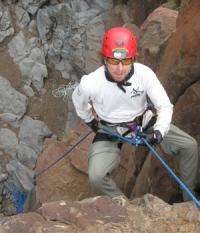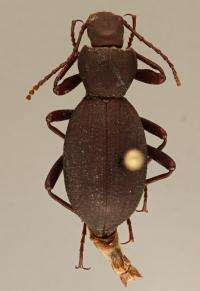Delving into darkness to discover new species

(Phys.org) -- Deep in the recesses of a northwestern Arizona cave, a beetle scuttles along the floor, navigating its way with its long antennae as hair-like tufts on its slender legs drag across the rocks.
It lives in darkness, hidden away from human eyes in what most would say is an uninviting, harsh environment. But this particular beetle is of interest—a newly discovered species—and could have gone unnoticed if not for the tenacity of a scientist at Northern Arizona University.
Jut Wynne, a biological sciences doctoral candidate and research ecologist with the Colorado Plateau Research Station at NAU, discovered this new species of beetle during a several-year study of caves on Grand Canyon-Parashant National Monument. This newly described beetle, Eleodes wynnei, currently known to occur only in northwestern Arizona and southwestern Utah, is the first species to bear his name.

Wynne, who earned his master’s degree in environmental science and policy from NAU, said the experience of having a species named after him is humbling, but he’s most concerned with providing good science and guidance on cave resource management decisions.
“Caves are one of the most sensitive habitats on our planet,” he said. “At the same time, given their location underneath our feet, these ecosystems have been overlooked from a resource management perspective.”
Wynne said several parks and monuments on the Colorado Plateau are working to change this practice. His experience working on Easter Island, associated with his doctoral studies, has shown that native species may still persist despite the drastic changes to the island’s ecosystem over the last several hundred years.
Since 2005, Wynne and his colleagues have identified three new genera and more than 20 new species of cave-dwelling arthropods in caves in the Grand Canyon region. He also discovered five new species from Rapa Nui National Park on Easter Island and four new species at El Malpais National Monument in western New Mexico.
Wynne said his travels into the darkest places on the planet aren’t rooted in leaving his name in the books of biological taxonomy.
“While having a new species share my family’s name is indeed a tremendous honor, we still have a lot of work to do studying and protecting this species and other animals that call caves their home.”
Provided by North Arizona University



















